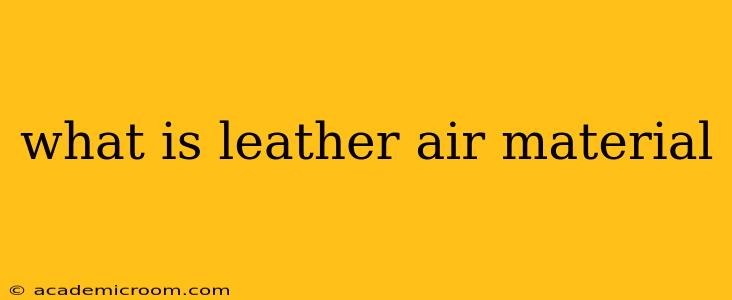What is Leather Air Material? Decoding the Breathable Leather Revolution
Leather, a material prized for its durability and luxurious feel, has traditionally been associated with a lack of breathability. However, advancements in leather technology have led to the development of "leather air" materials, offering a superior alternative that combines the best of both worlds: the classic look and feel of leather with significantly enhanced breathability. But what exactly is leather air material? Let's delve into the details.
Leather air material isn't a single, specific type of leather. Instead, it's a broader term encompassing various techniques and processes aimed at improving the breathability of leather. These techniques often involve manipulating the leather's structure at a microscopic level, creating small pores or channels that allow air to circulate more freely.
How is Leather Air Material Made?
Several methods contribute to the creation of breathable leather. These include:
-
Microperforation: This involves creating tiny holes in the leather's surface using laser technology or other precision tools. The size and density of these holes can be controlled to optimize breathability while maintaining the leather's structural integrity.
-
Advanced Tanning Processes: Modern tanning techniques can influence the leather's porosity. Some processes leave the leather more open and less dense, naturally enhancing breathability.
-
Combination with Other Materials: Sometimes, leather air materials incorporate other breathable fabrics, such as mesh or specialized textiles, to further boost air circulation. These combinations can create a layered material with enhanced comfort and breathability.
-
Chemical Treatments: Specific chemical treatments can modify the leather's structure at a molecular level, increasing its permeability to air. However, it's crucial to ensure these treatments are environmentally friendly and do not compromise the leather's durability or safety.
What are the Benefits of Leather Air Material?
The primary advantage of leather air material is its improved breathability. This translates to several key benefits:
-
Increased Comfort: Leather air materials are significantly more comfortable to wear, especially in warm or humid conditions. They reduce sweating and prevent the clammy feeling often associated with traditional leather.
-
Enhanced Hygiene: Better breathability helps to prevent the build-up of moisture and sweat, creating a less hospitable environment for bacteria and fungi. This can improve hygiene and reduce the risk of skin irritation.
-
Improved Durability (in some cases): While not always guaranteed, some leather air materials can exhibit enhanced durability due to the improved air circulation, which can help to prevent premature wear and tear from moisture damage.
What Products Use Leather Air Material?
Leather air material finds applications in a variety of products, including:
-
Apparel: Jackets, coats, gloves, and other garments can benefit from the improved comfort and breathability offered by leather air materials.
-
Footwear: Shoes and boots made with leather air materials offer a more comfortable and less sweaty experience, especially for those who spend long hours on their feet.
-
Accessories: Bags, wallets, and other leather accessories can also utilize leather air material for improved comfort and hygiene.
-
Automotive Interiors: Some high-end vehicles may use leather air materials in their seating to provide increased comfort and breathability for passengers.
Is Leather Air Material More Expensive?
Generally, yes. The advanced techniques and processes involved in creating leather air material often result in a higher cost compared to traditional leather. However, the improved comfort, hygiene, and potentially enhanced durability can justify the price for many consumers.
How Do I Care for Leather Air Material?
Caring for leather air material is similar to caring for traditional leather, but with a few key considerations. Always check the manufacturer's recommendations, but generally, you should avoid harsh chemicals and abrasive cleaners. Regular cleaning with a damp cloth and leather conditioner can help maintain its appearance and longevity.
By understanding the properties and benefits of leather air material, consumers can make informed choices when selecting leather products, prioritizing comfort, hygiene, and durability. The continued innovation in leather technology promises even more advanced and breathable leather options in the future.
